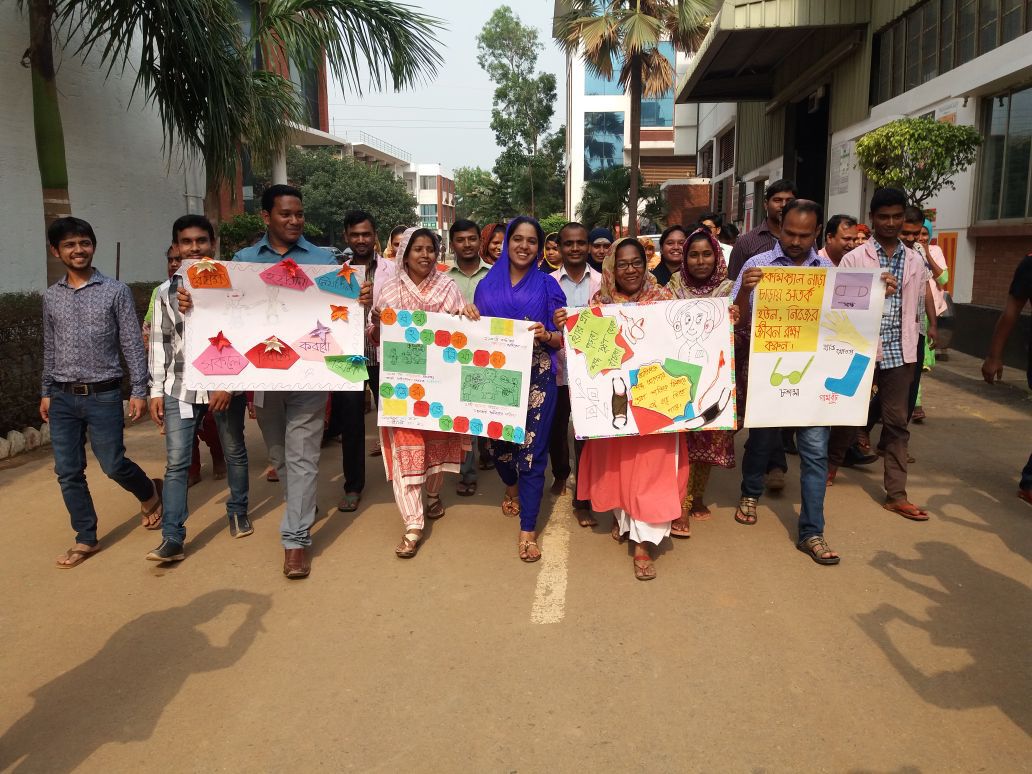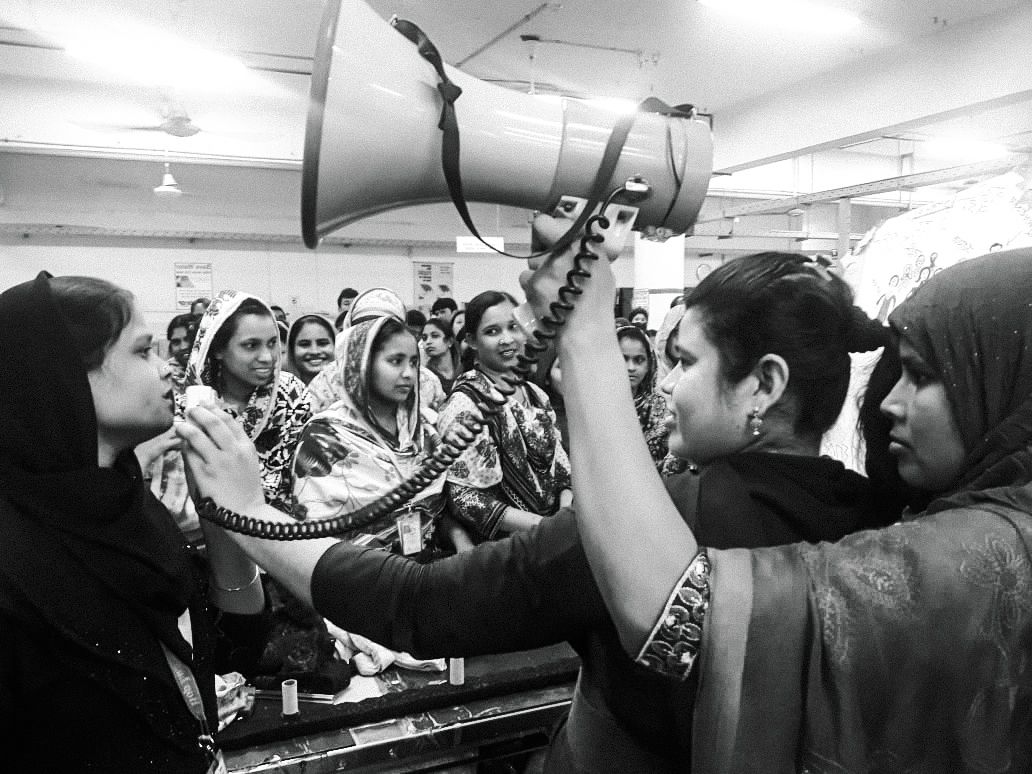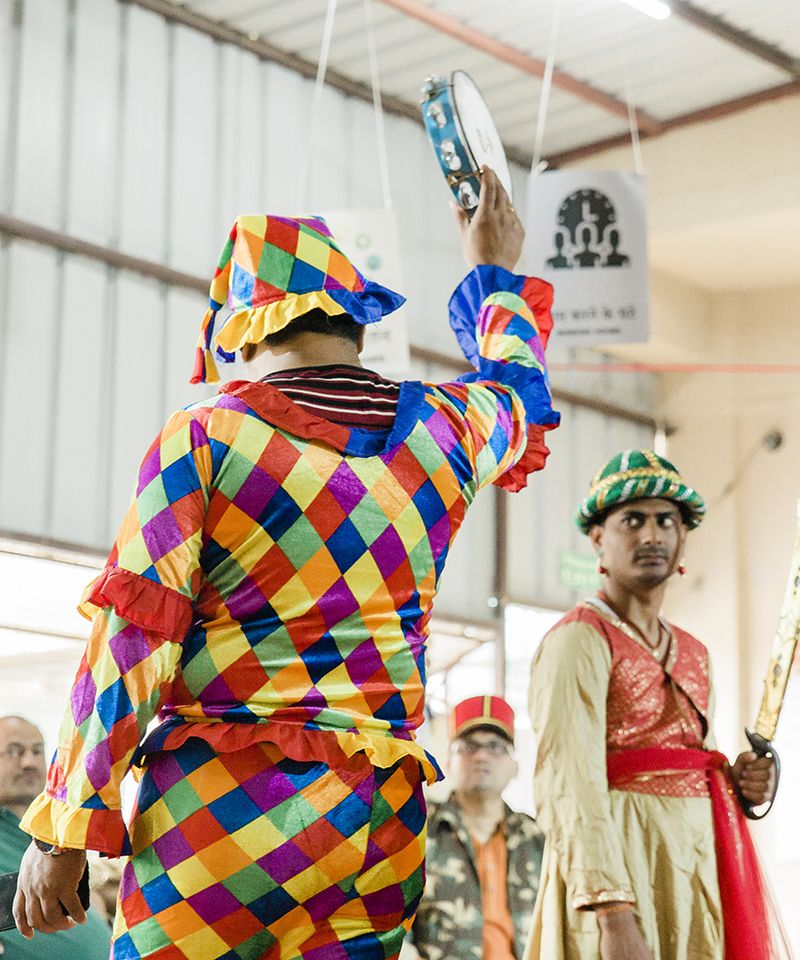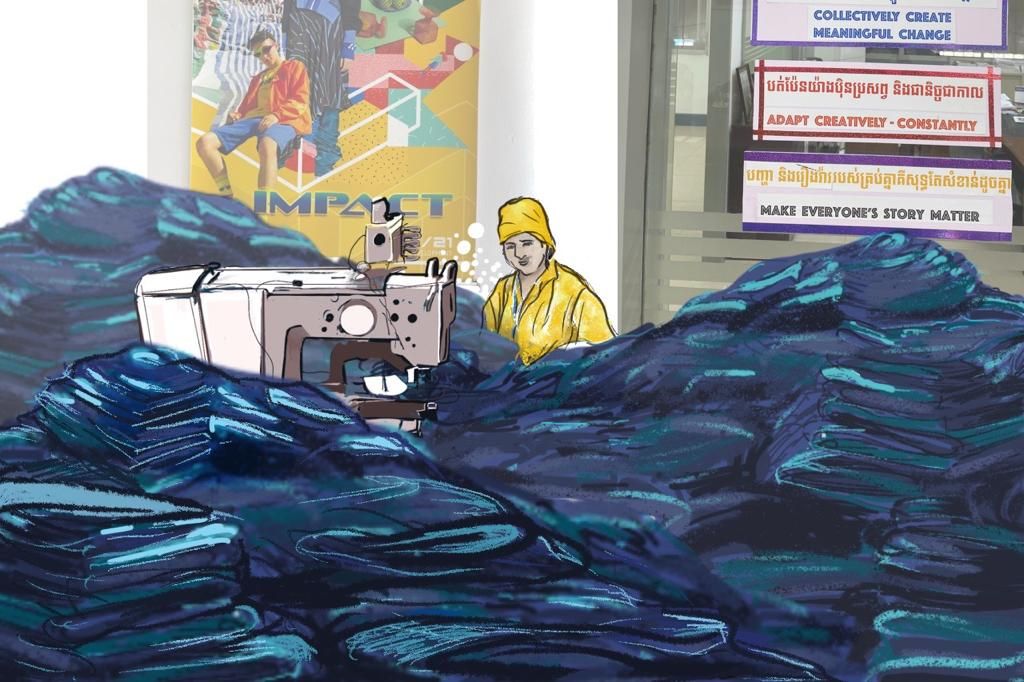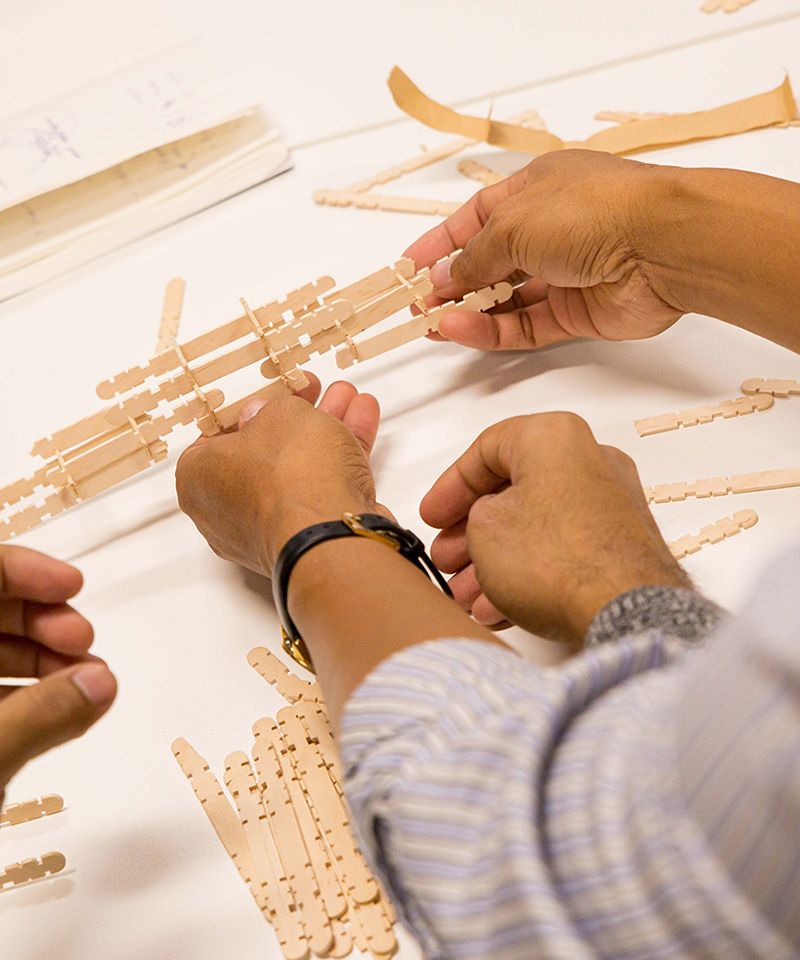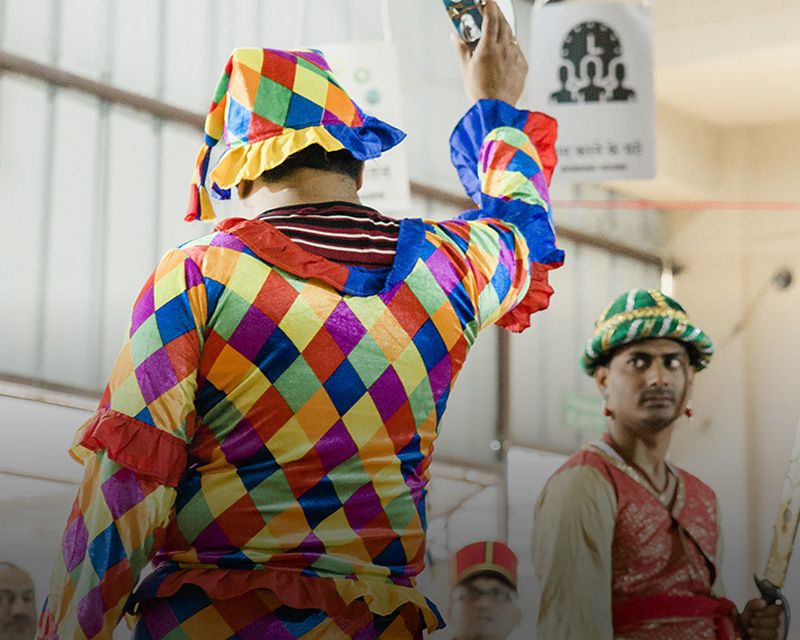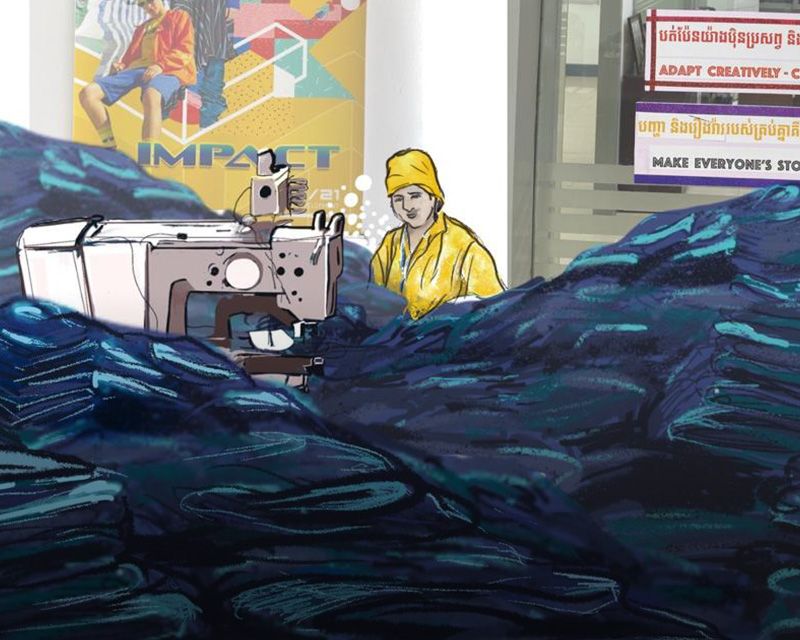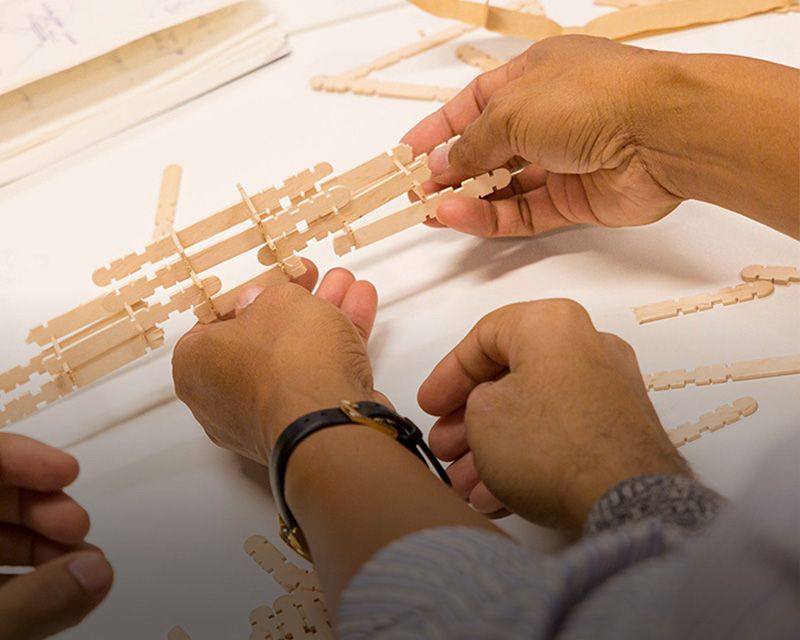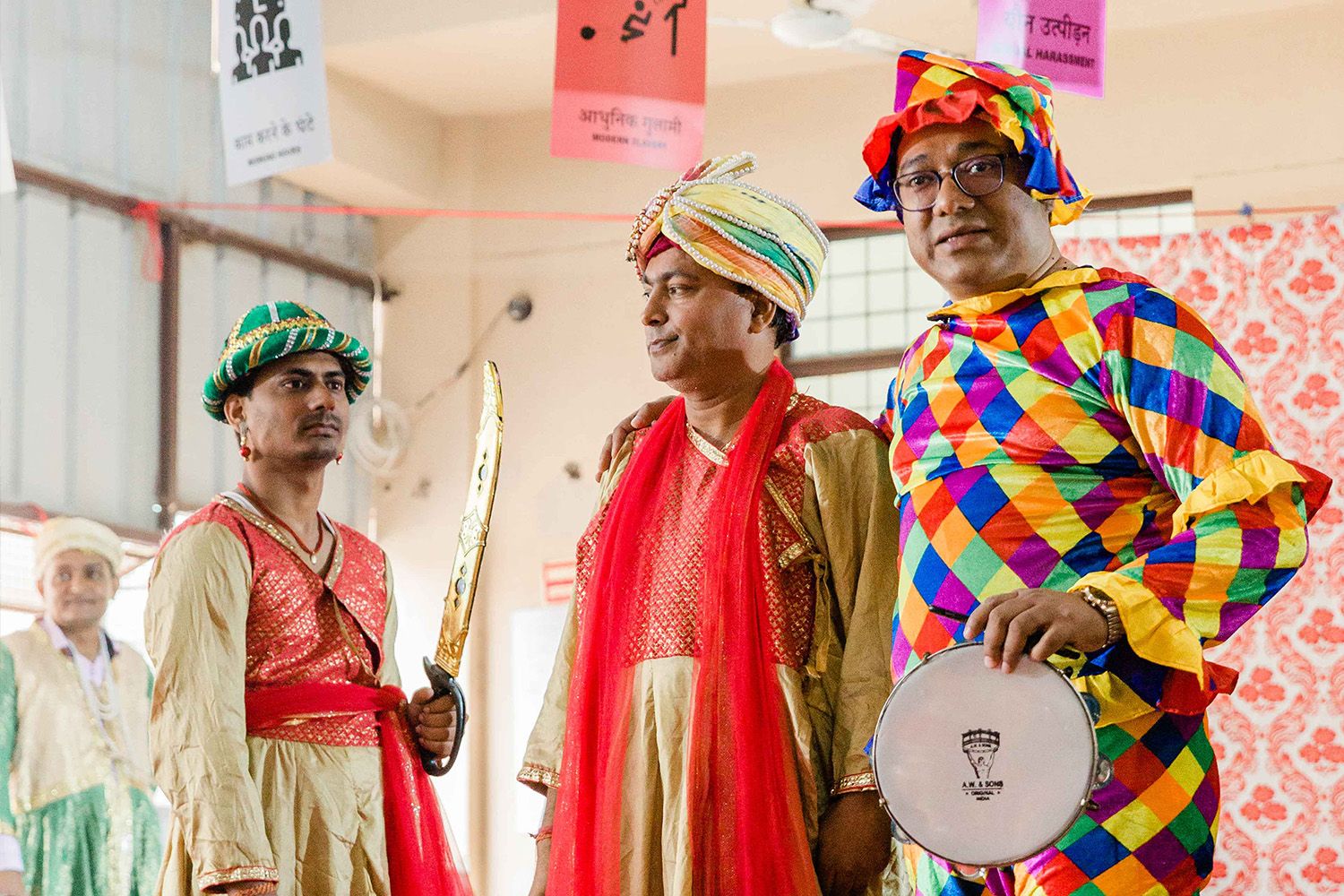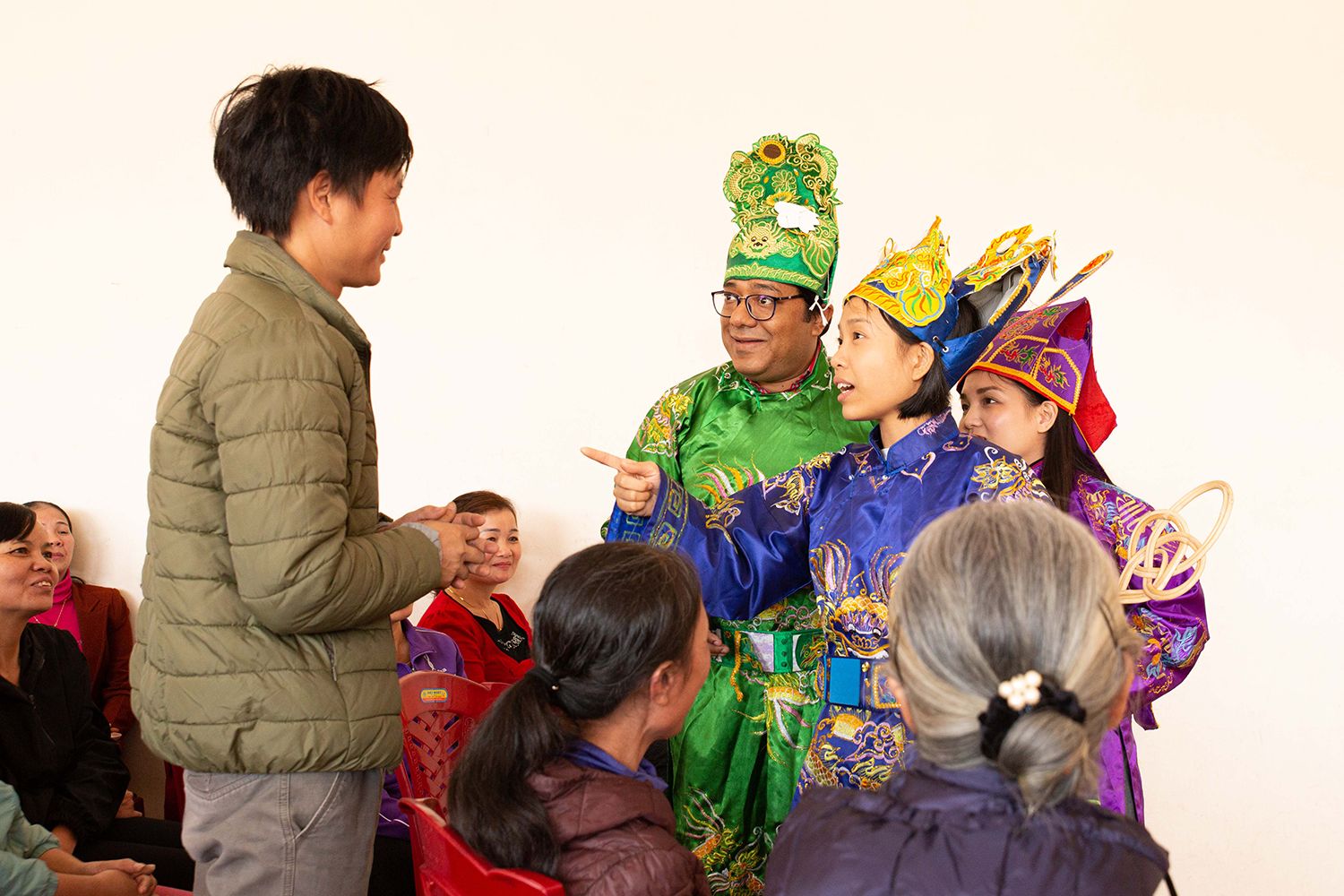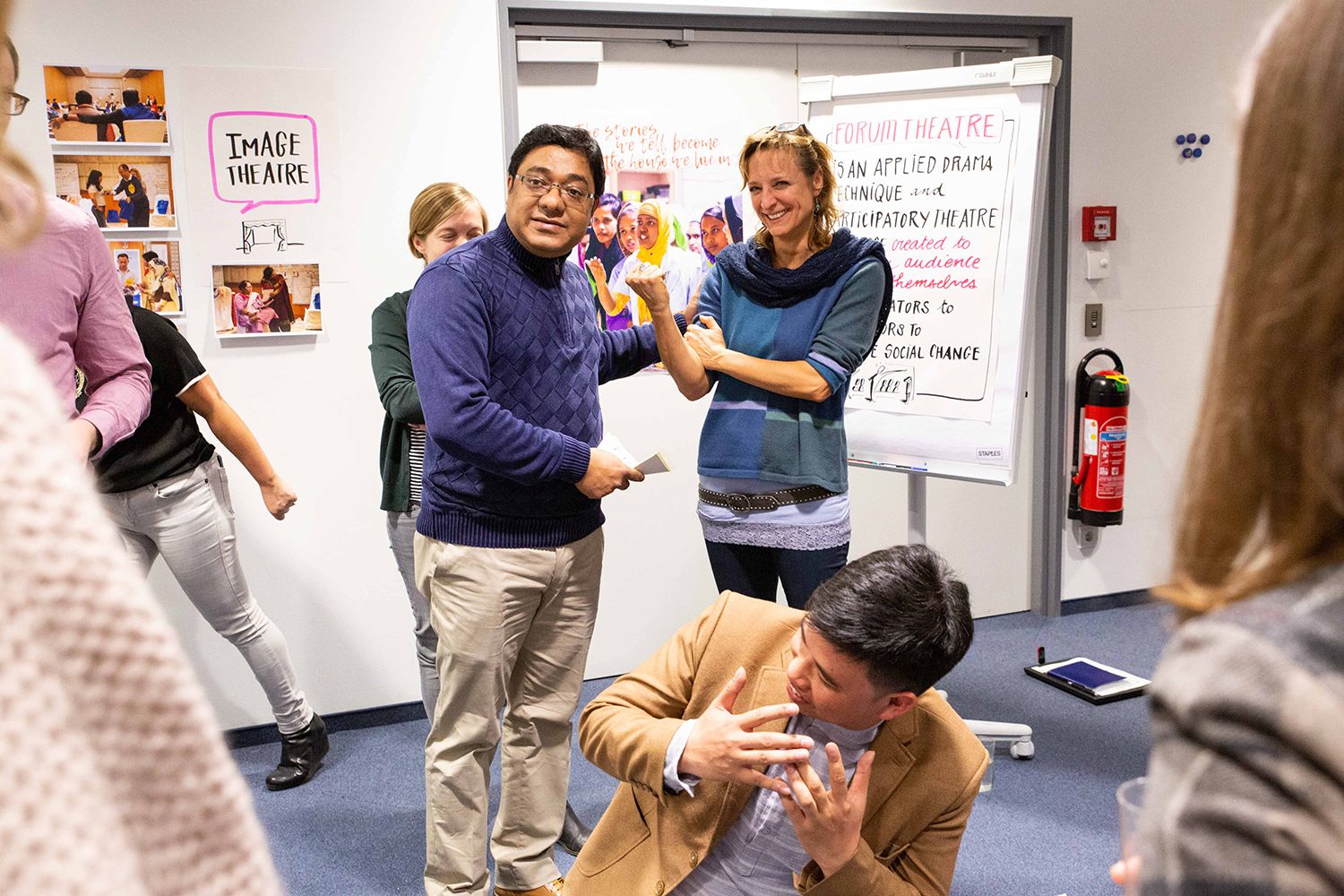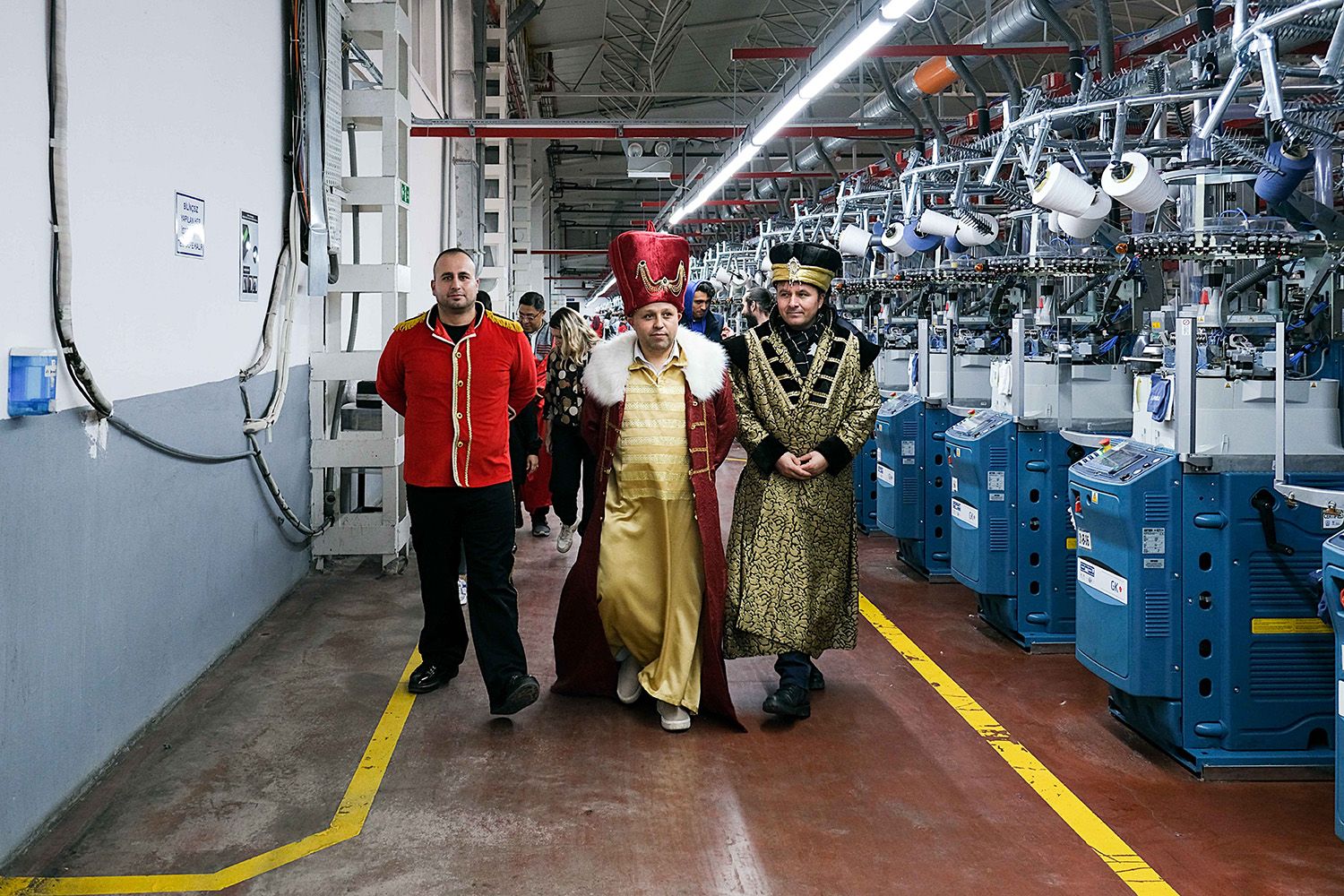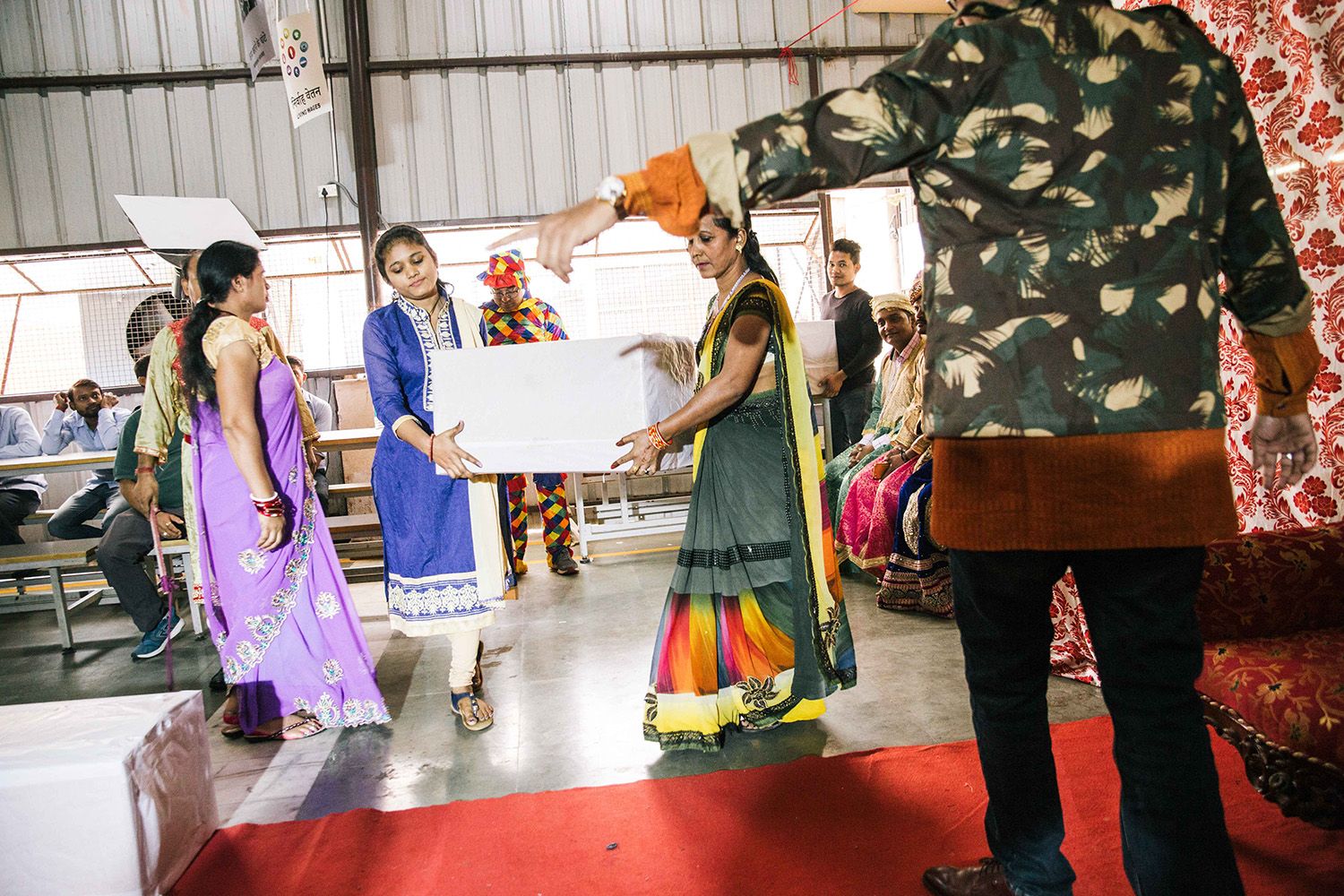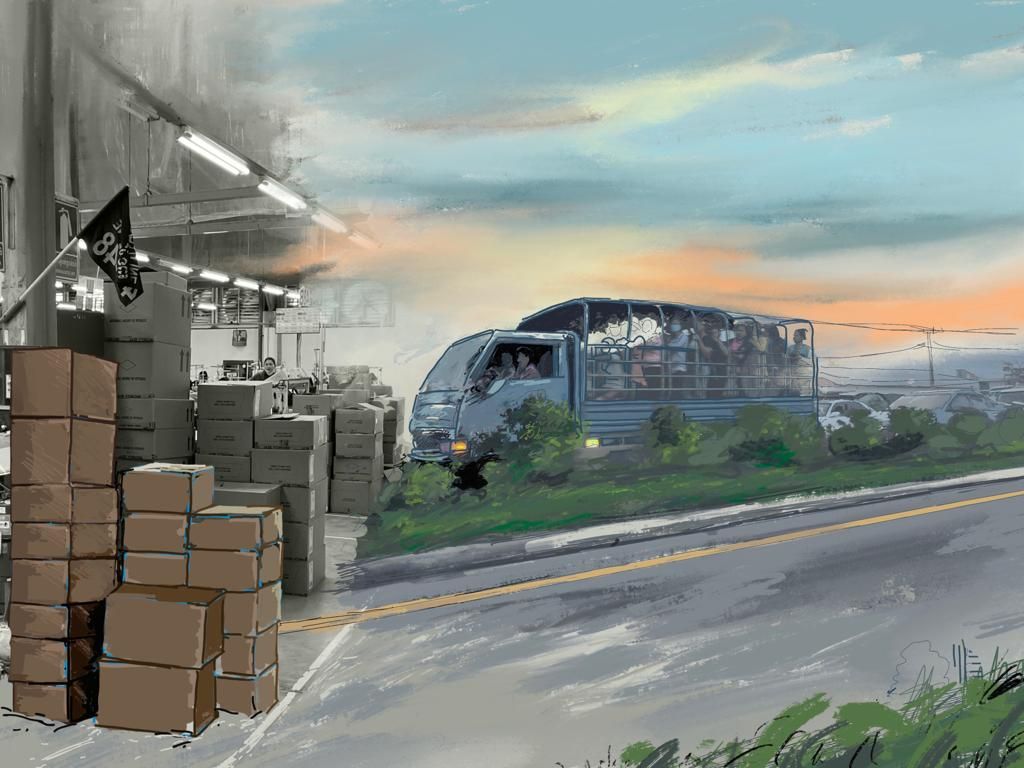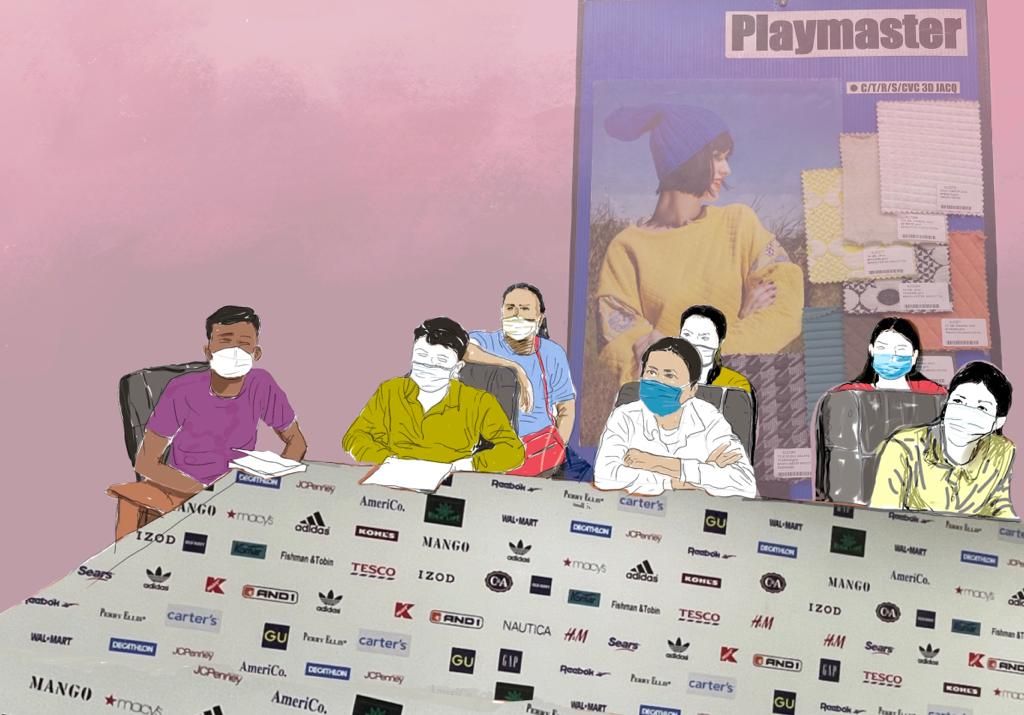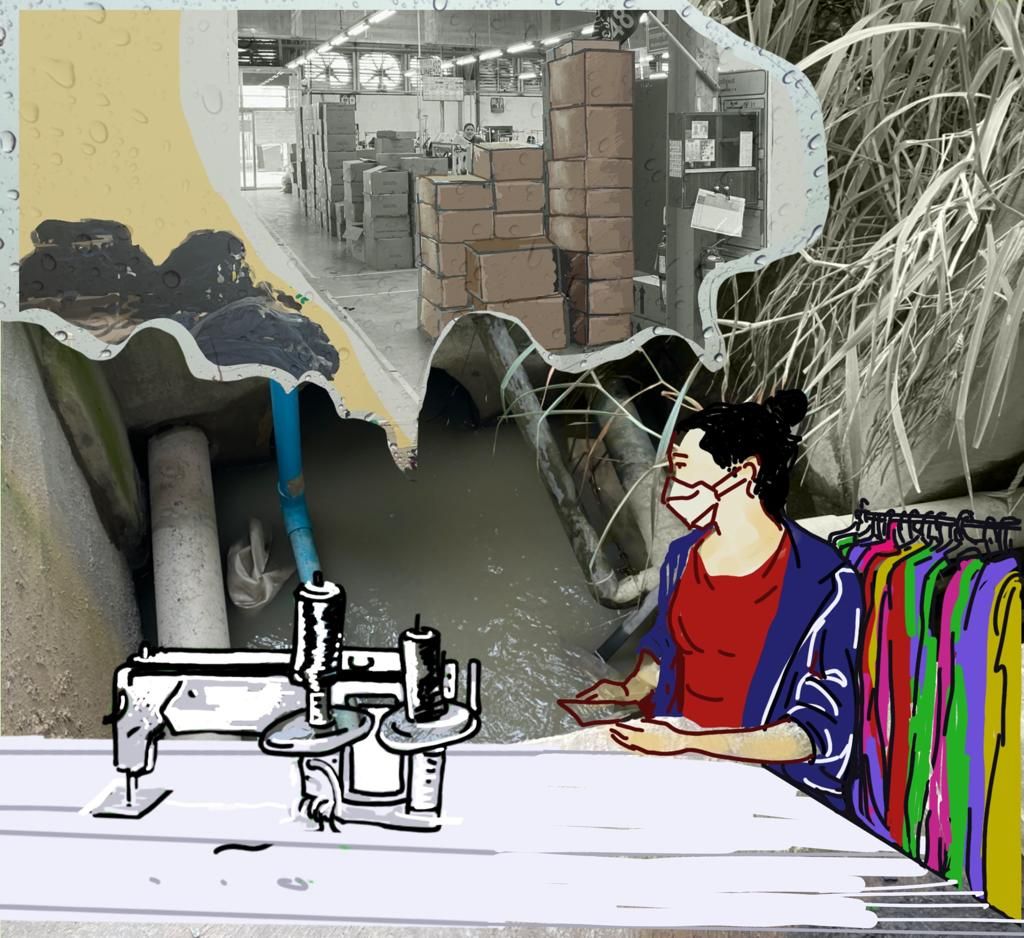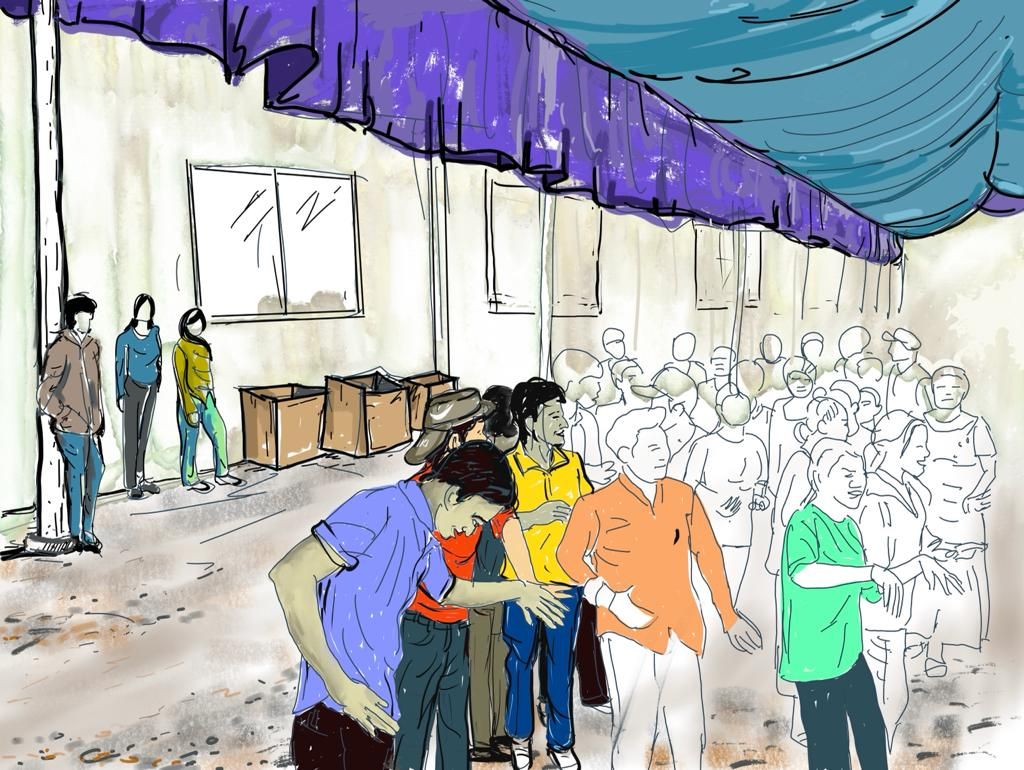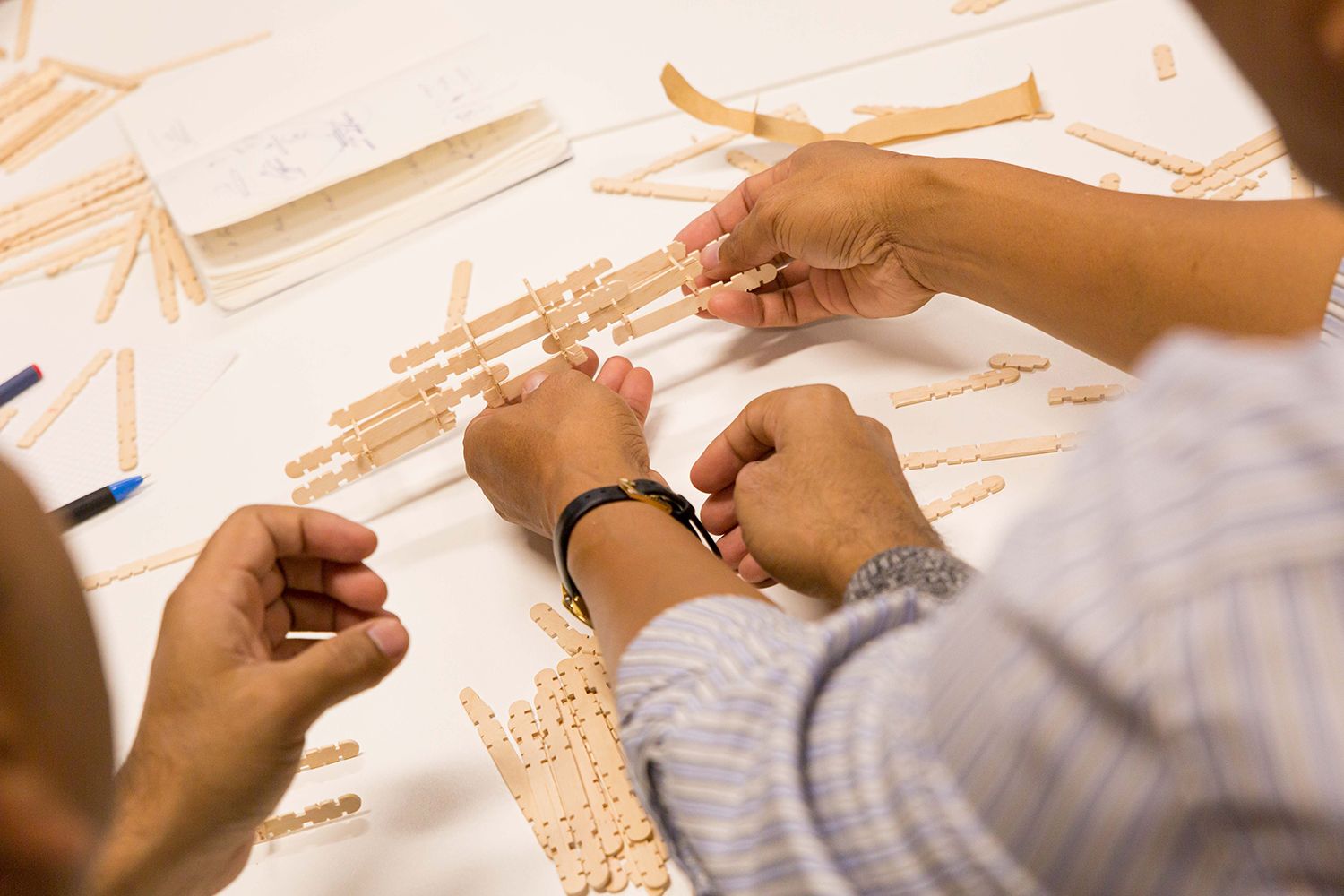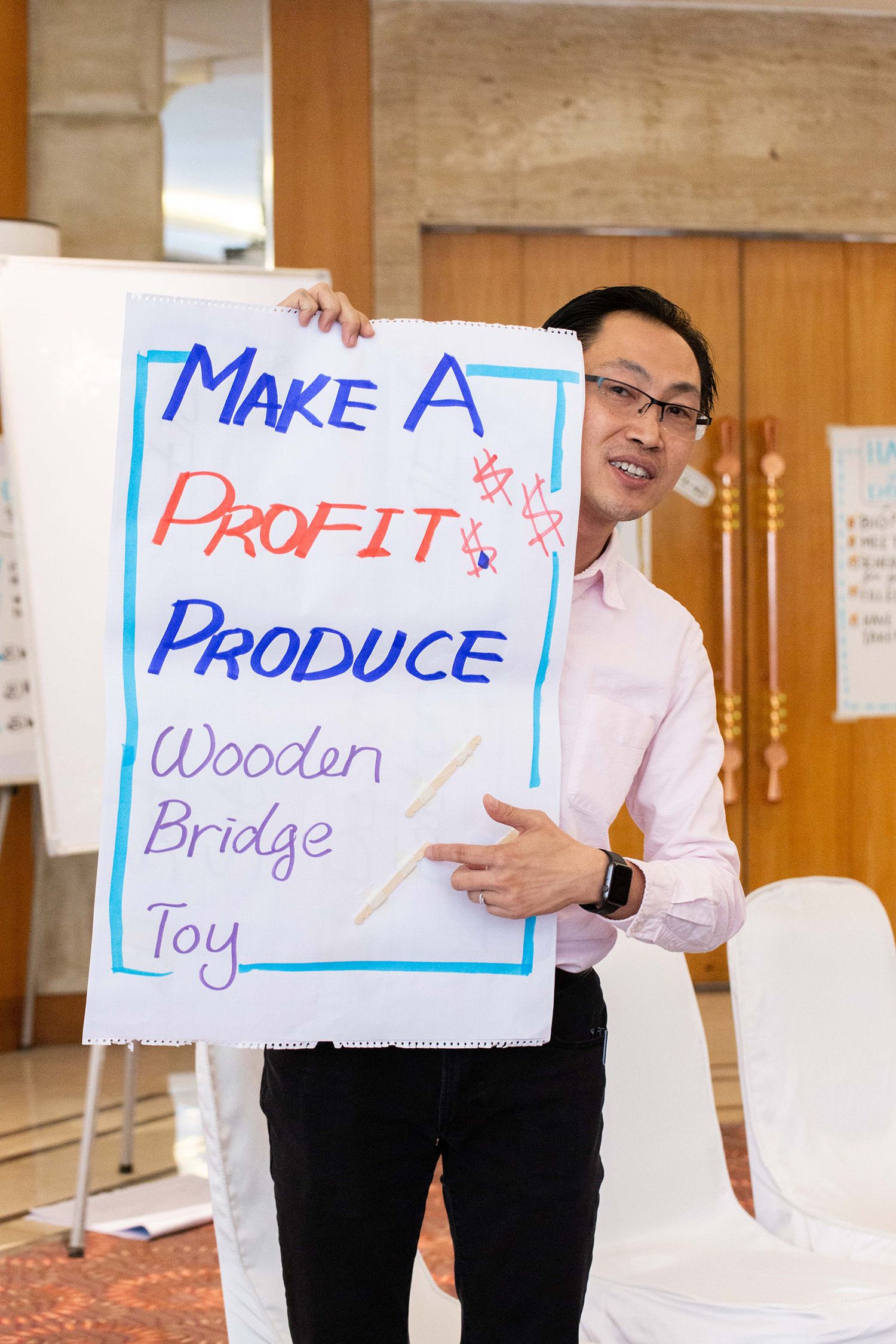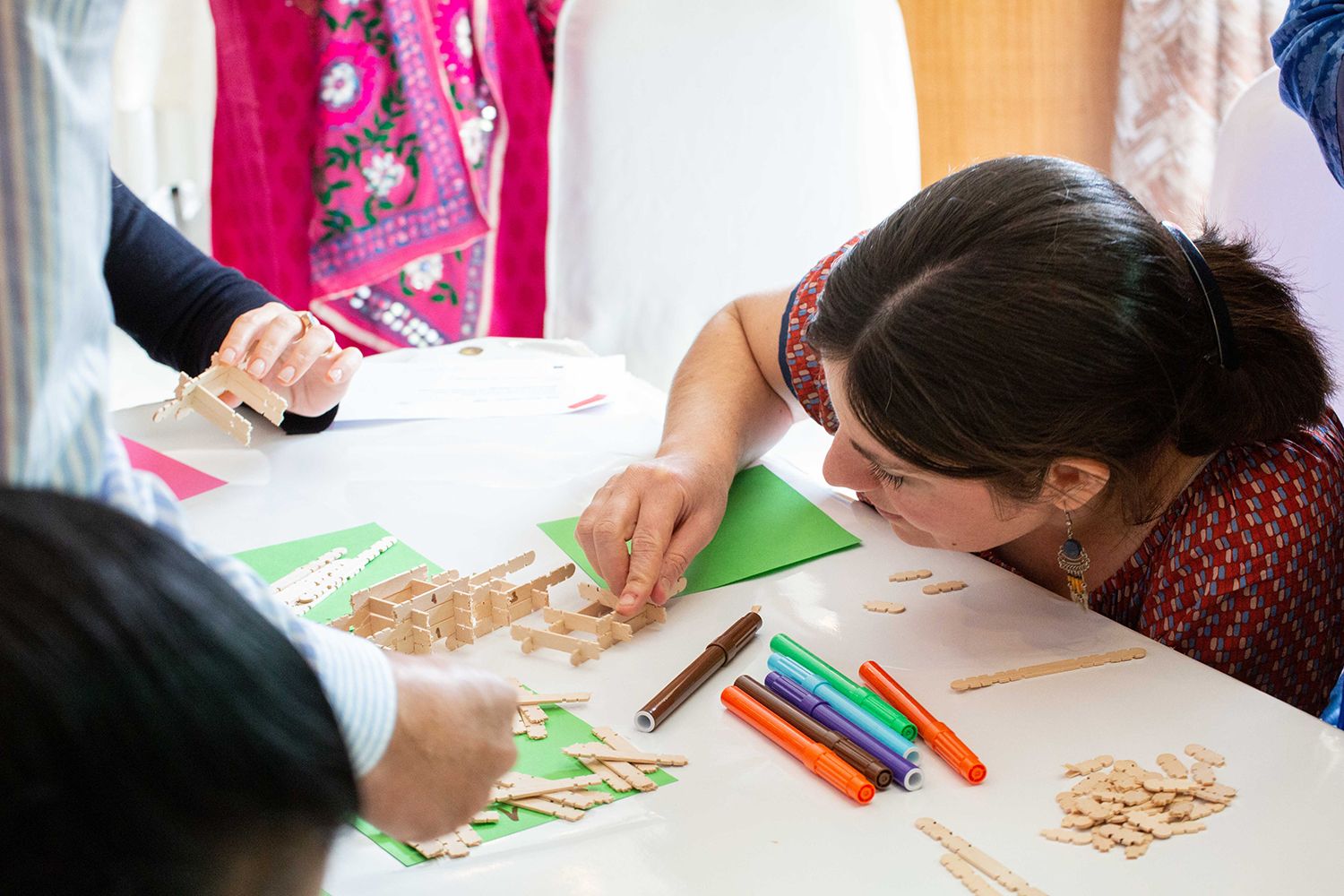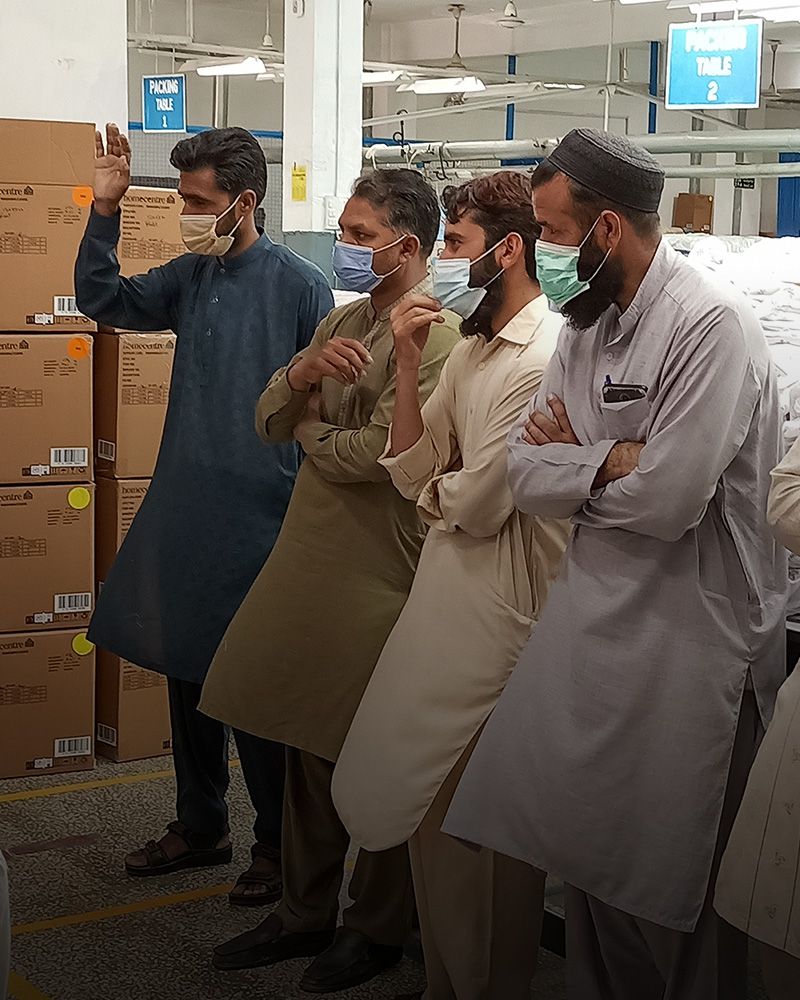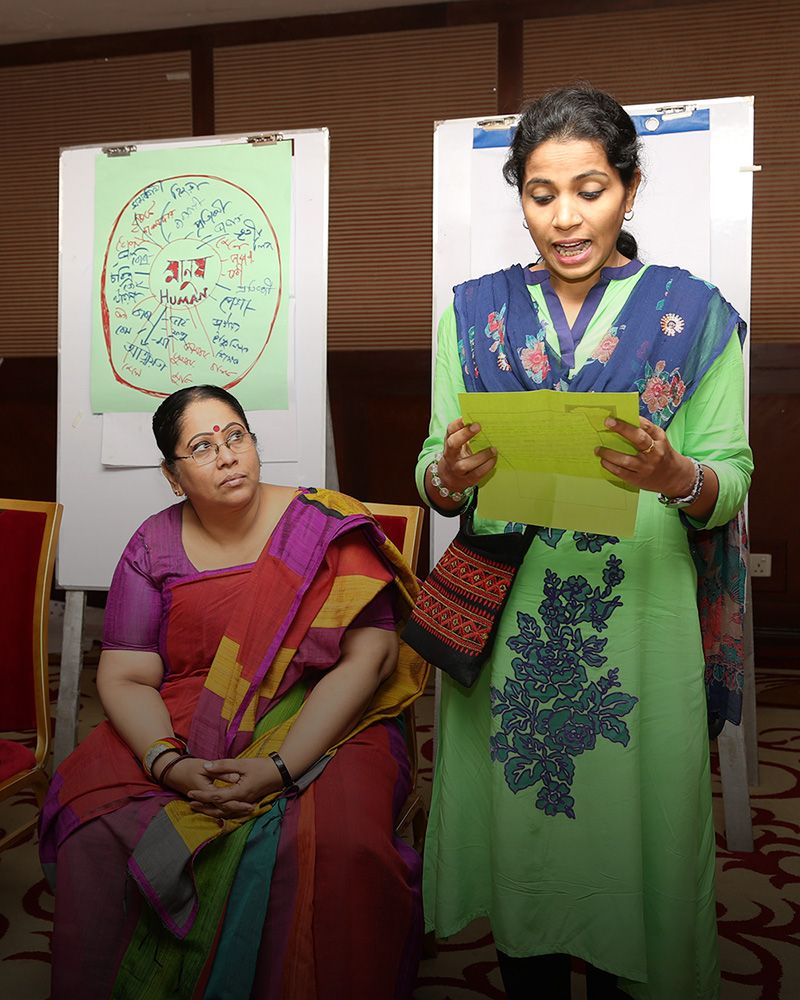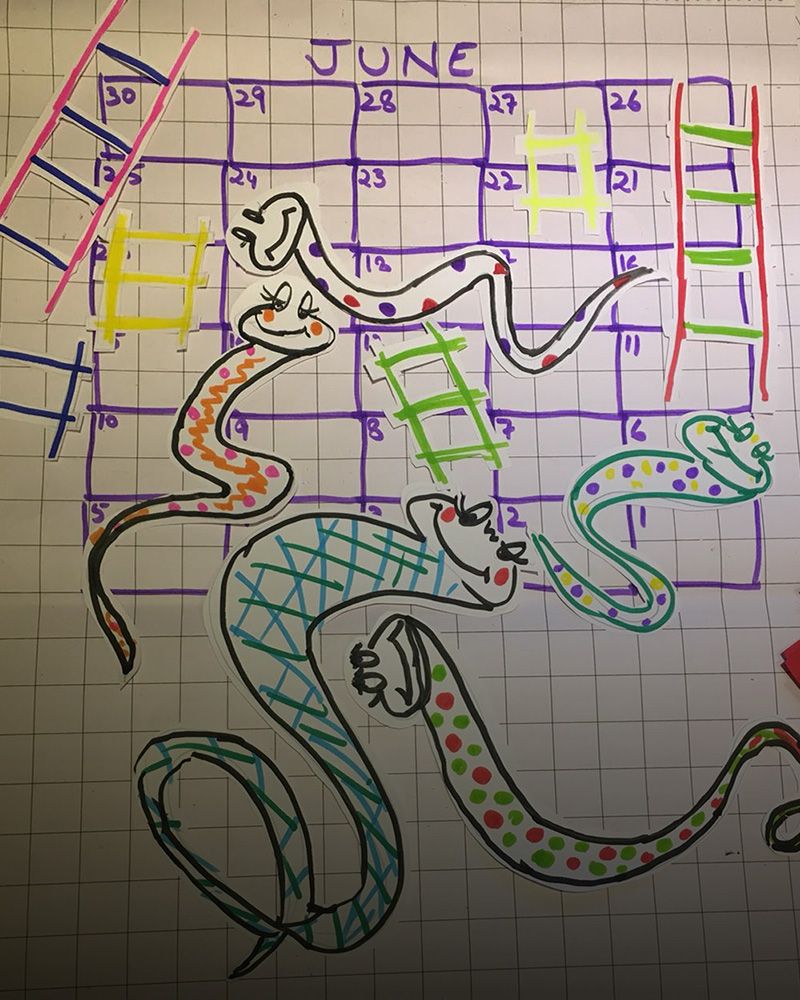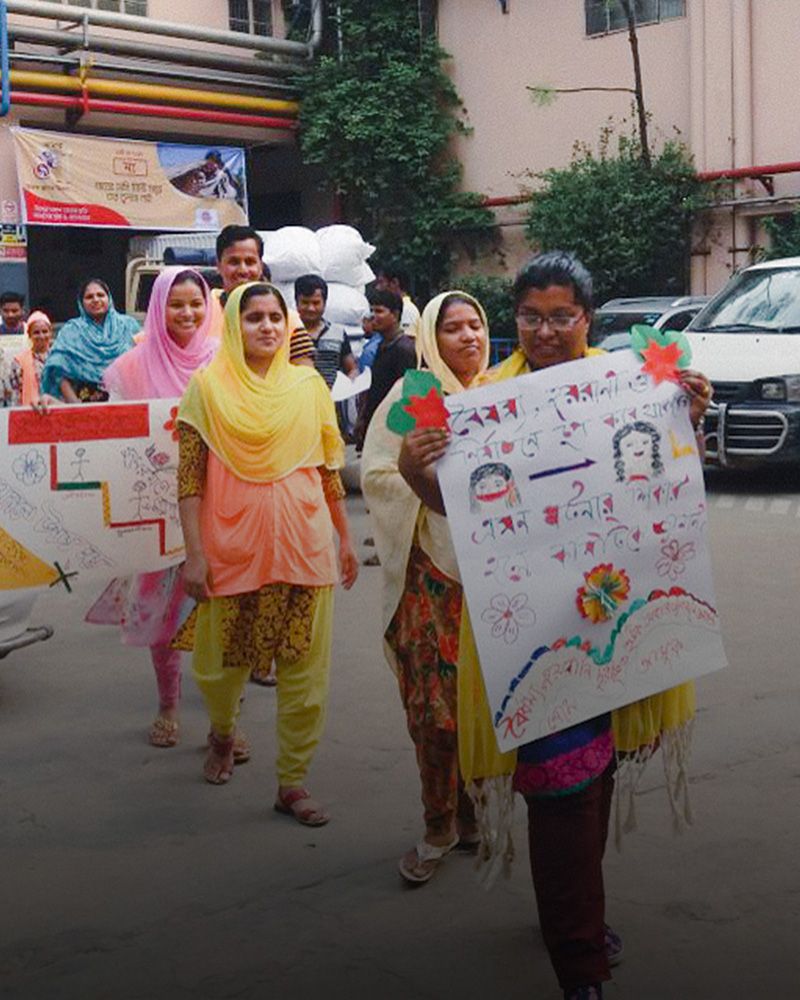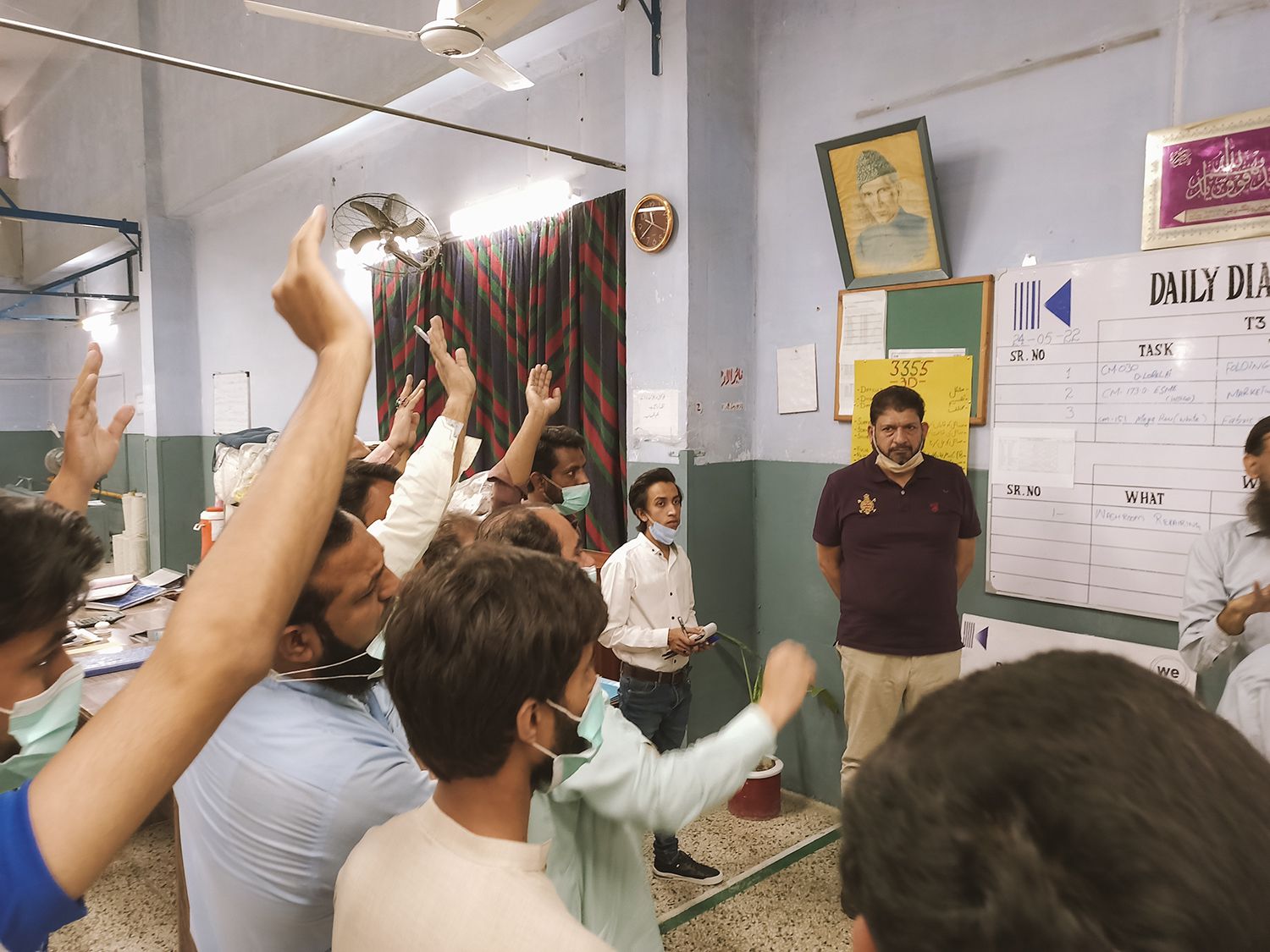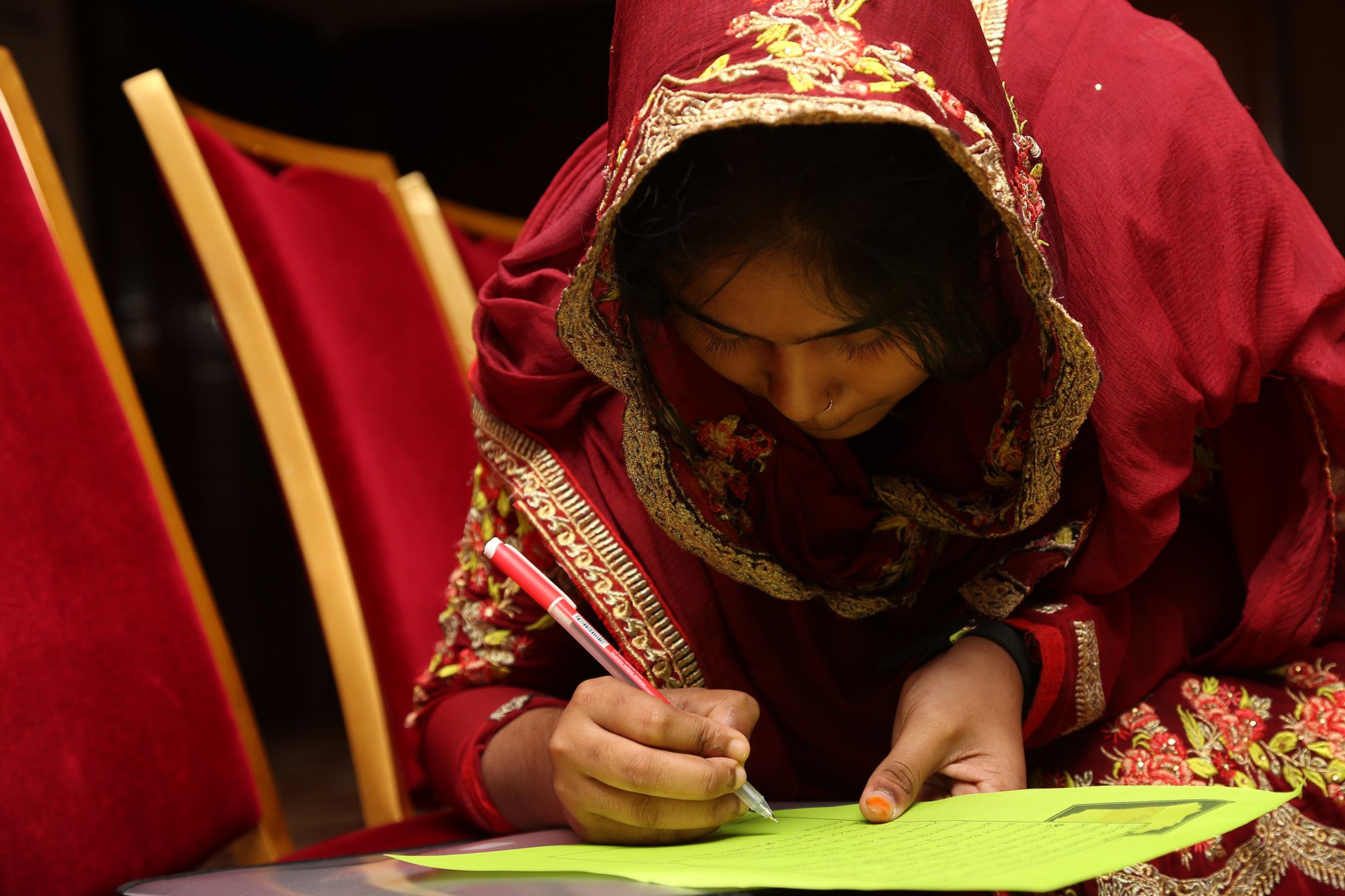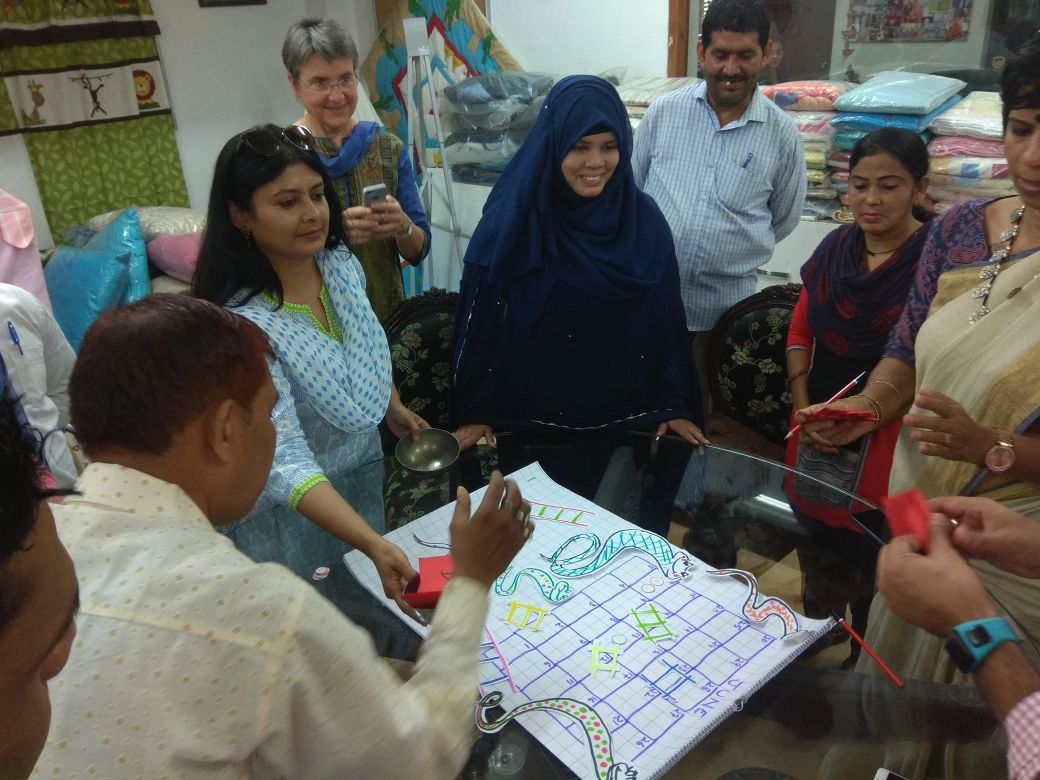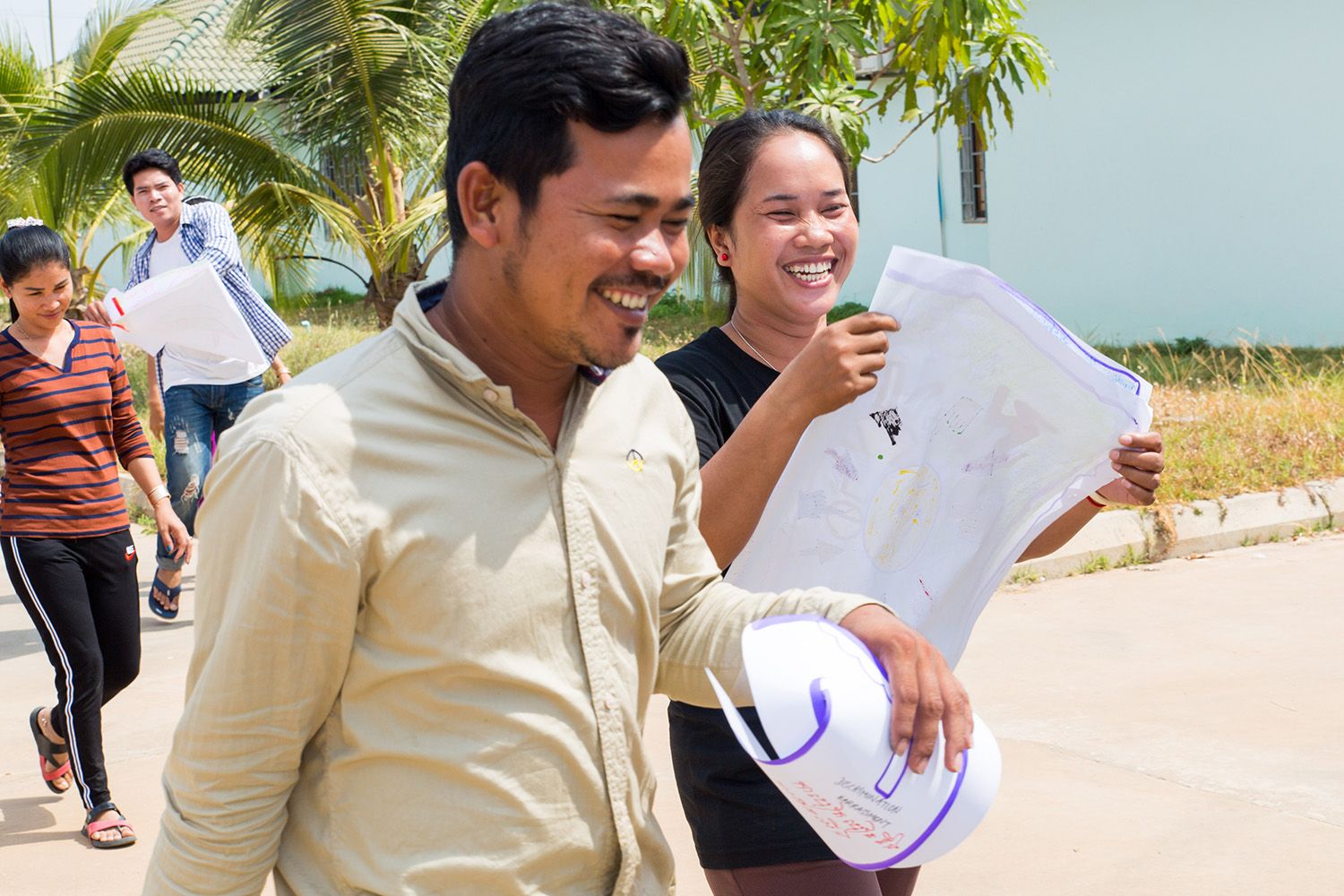WE AT WORK
For us dialogue is not just ‘people talking’; it is a structured process. When we say ‘structured’, we don’t mean we opt for safe routine. To truly invite participation, we combine the skills of facilitation with the creativity and activism of art.
We build on the knowledge and experience of many others. Human System Dynamics, Conflict Resolution, Deep Democracy, Theory U, Forum Drama, Appreciative Inquiry and Applied Creativity; we bring it all and more. Curious to know what WE looks like in action? Our stories about how we work are full of heart, ideas, and insights. You can check them out here.
STAGING
FORUM DRAMA
BY NEEL
“We proposed a basic story line from a very popular Bollywood movie, knowing it would resonate. And then we asked the workers: ‘Do you think we can replace these characters with your stories, your realities? They came up with characters, with dialogues and in the end, we had this beautiful Forum Drama on the hazards of working in the factory and how life changes after an industrial accident.”
STAGING
FORUM DRAMA
BY NEEL
“We proposed a basic story line from a very popular Bollywood movie, knowing it would resonate. And then we asked the workers: ‘Do you think we can replace these characters with your stories, your realities? They came up with characters, with dialogues and in the end, we had this beautiful Forum Drama on the hazards of working in the factory and how life changes after an industrial accident.”
CAMBODIA
DIALOGUES
BY SOTHEARAT
“Because of Covid-19, we were not able to visit the factories and run the WE program as we normally do. The pandemic pushed us to doing something else. We started exploring this story telling probe and interviewed all the members of two factory WE teams. Initially, we did not think big. None of us anticipated the possibilities of this project when we took off. But in the end, it turned into a book, for which I even made the illustrations.”
THE CAMBODIA DIALOGUES
By Sang & Sothearat
“Because of Covid-19, we were not able to visit the factories and run the WE program as we normally do. The pandemic pushed us to doing something else. We started exploring this story telling probe and interviewed all the members of two factory WE teams. Initially, we did not think big. None of us anticipated the possibilities of this project when we took off. But in the end, it turned into a book, for which I even made the illustrations.”
THE BRIDGE
GAME
BY ANTHONY
“I believe games like these are great tools to give participants insight and experience and open them up to talk about difficult topics. Starting from a less personal, realistic, but not necessarily real situation leads to the discussion on real-world issues and dynamics.”
THE BRIDGE
GAME
BY NEEL
“We proposed a basic story line from a very popular Bollywood movie, knowing it would resonate. And then we asked the workers: ‘Do you think we can replace these characters with your stories, your realities? They came up with characters, with dialogues and in the end, we had this beautiful Forum Drama on the hazards of working in the factory and how life changes after an industrial accident.”
WE is not for everyone, but it may be for you.
DAILY
DIALOGUE WALK
TOLD BY HAIDER
“I’ve been engaged in more than fifty factories in Pakistan, since 2004, working to improve productivity. In many cases good results were achieved in the pilot phase. But I noticed they could not be sustained afterwards. When I joined the German organisation for international co-operation GIZ as technical advisor in 2014, I started learning about the dialogue approach and I realized the critical importance of engaging frontline workers, a missing link in my previous assignments.
In the garment industry in Pakistan workers are not employees, they are contractors. When a huge order is about to come in, senior managers tell their middle managers: go get people. The managers only think of them as a source of production, not as human beings. And they certainly don’t think of them as being of any help in improving productivity or business. Nor does it occur to the workers that they could be involved.
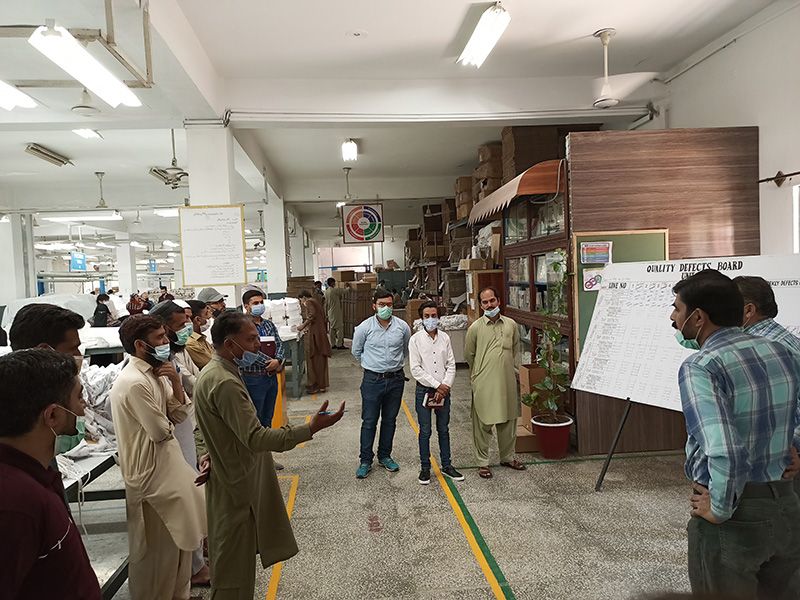
This is why dialogue has such impact. For the first time, the workers are being listened to. And the managers actually implement their good ideas. And what’s more: their managers then start to think of them as assets. They start thinking: I should employ them. Then I will benefit even more from their ideas.
So, unleashing the human potential through dialogue is a powerful approach to bring change both at an organisational, individual, and societal level. I strongly believe that listening to the workers’ perspectives with deep empathy can bring lasting results. It is a real drive for me to be in WE.”
So, unleashing the human potential through dialogue is a powerful approach to bring change both at an organisational, individual, and societal level. I strongly believe that listening to the workers’ perspectives with deep empathy can bring lasting results. It is a real drive for me to be in WE.”
THE IMPACT OF
REAL LIFE STORIES
TOLD BY FATIMA
“A small family-owned garment factory just outside of Dhaka was represented during a kick-off meeting by a mixed group of workers and management. They were a point of concern for the facilitators, because they knew the workers had not really been exposed to this kind of training before. Also, in previous workshops, both workers and management had been shy and did not participate wholeheartedly. To the facilitators’ surprise, they visibly opened up during the first workshop, after seeing people from other factories participate enthusiastically.
After lunch all participants came together again in a large room for a writing session. Everyone present was asked to write an anonymous letter about their personal experience with harassment, abuse or violence and drop this letter in one of three boxes with similar captions. After this a circle was formed and one by one all participants were asked to take letter from the box and read it out loud in front of the group.
Excerpt from one of the letters: “It gives me great pain to see women in my factory operating heavy machines when they are well into their sixth or seventh month of pregnancy. They have to work equally hard as others to ensure production quota are met. And if they fail to comply with their prescribed task, the supervisors show no mercy. They start yelling at them and use abusive language such as ‘bastard’ or ‘motherfucker’.”
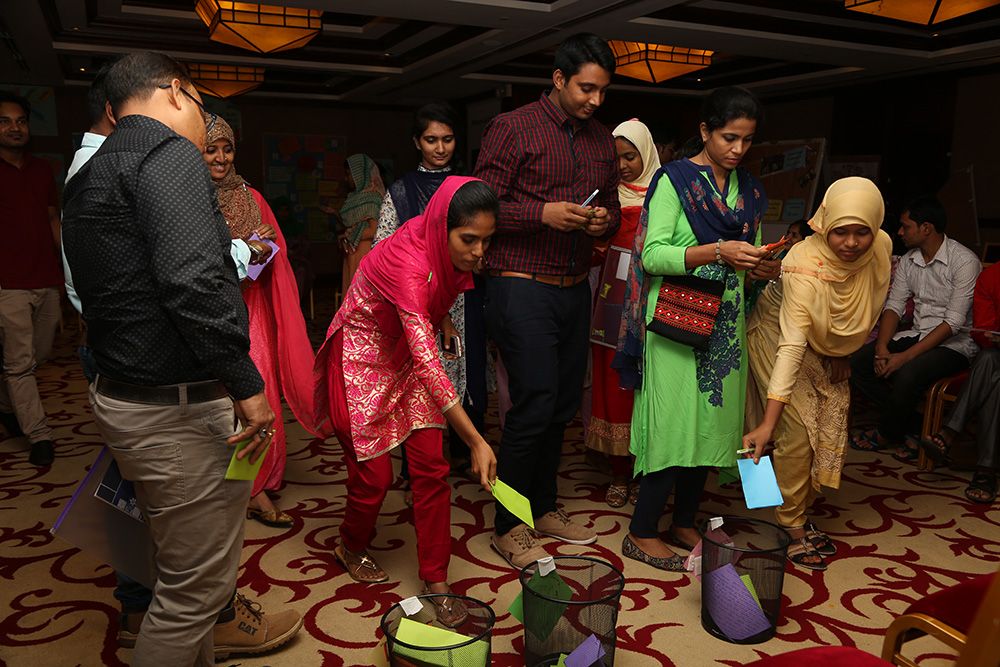
The room grew very quiet while listening. People were visibly moved and some of them cried. The anonymity of the stories made every single letter a shared experience, instead of a personal one.
When all letters were read, the managers in the group were asked to work in teams together on what they’d heard. Instruction: ‘If I were a worker, what would I have done…’ The workers were asked to write about: ‘If I were a manager, what would I have done…’
After finishing this exercise there was a mutual understanding that every single story they’d listened to centred around problems that could only be solved together.
Six weeks after the kick-off training, our WE facilitators visited the small factory. They’d seen the training had caused a shift of mind and they wanted to do a follow-up to help them to continue the discussion. When the facilitators arrived, they heard to their surprise that what was learned during the kick-off meeting had already been replicated. The management had made printouts of posters made by WE-facilitators and pasted them to a wall for discussion in the factory. They had also made three baskets named Harassment, Abuse and Violence for workers to drop personal notes in and the preserved letters showed that this was experienced as a safe way to share difficult experiences. The proactive nature of the management had increased significantly and the improved relationship between management and workers was noticeable. During this visit they did not bother about their closing time or finishing their duties."
Six weeks after the kick-off training, our WE facilitators visited the small factory. They’d seen the training had caused a shift of mind and they wanted to do a follow-up to help them to continue the discussion. When the facilitators arrived, they heard to their surprise that what was learned during the kick-off meeting had already been replicated. The management had made printouts of posters made by WE-facilitators and pasted them to a wall for discussion in the factory. They had also made three baskets named Harassment, Abuse and Violence for workers to drop personal notes in and the preserved letters showed that this was experienced as a safe way to share difficult experiences. The proactive nature of the management had increased significantly and the improved relationship between management and workers was noticeable. During this visit they did not bother about their closing time or finishing their duties."
SNAKES AND
LADDERS
TOLD BY MOON
“Snakes and Ladders is a multiple player ancient Indian roll and move game. The board is made up of squares full of traps and tricks. Ladders will take you up, Snakes will take you down. In this particular case we – the WE facilitators - had adapted the game board to the topic of living wages.
For each day of the upcoming month there was a square confronting the players with the money related challenges of daily life. Landing on a ladder could give you an easy shortcut or a stroke of luck (meaning extra money). A snake would confront you with extra expenses or a financial setback. Salary is paid out on a certain day, overtime gets reimbursed, there may be extra income from other sources, but you can also be confronted with medical bills, school fees et cetera. We played the game with a mixed group of about 15 people present: workers, floor supervisor, HR manager, compliance manager and the owners of this family business.
We used this tool to kick-start a discussion about ‘living wages versus minimum wages’. By playing a game we wanted to create a light-hearted, open atmosphere, since this is a difficult subject. First of all we notice on a regular basis there is confusion about the difference between minimum wages and living wages among workers and management. Secondly, in India there is no agreed upon living wage. Even the most conservative estimate of living wages is almost twice the amount of the current minimum wage. When we addressed this in the past, the conversation could steer towards blaming the buyers, owners or managers of the factory as if they were cheating the workers out of wages. And then a discussion would start on why they should get a raise on their current salary. We wanted to emphasize that the company is not doing anything illegal by paying their workers the standard minimum wages. And then proceed towards having an open dialogue about living wages, without finger pointing and making it management versus workers. We relied on the WE principle that we’re not there to fix individual problems, we want to make an industry change.
We used this tool to kick-start a discussion about ‘living wages versus minimum wages’. By playing a game we wanted to create a light-hearted, open atmosphere, since this is a difficult subject. First of all we notice on a regular basis there is confusion about the difference between minimum wages and living wages among workers and management. Secondly, in India there is no agreed upon living wage. Even the most conservative estimate of living wages is almost twice the amount of the current minimum wage. When we addressed this in the past, the conversation could steer towards blaming the buyers, owners or managers of the factory as if they were cheating the workers out of wages. And then a discussion would start on why they should get a raise on their current salary. We wanted to emphasize that the company is not doing anything illegal by paying their workers the standard minimum wages. And then proceed towards having an open dialogue about living wages, without finger pointing and making it management versus workers. We relied on the WE principle that we’re not there to fix individual problems, we want to make an industry change.
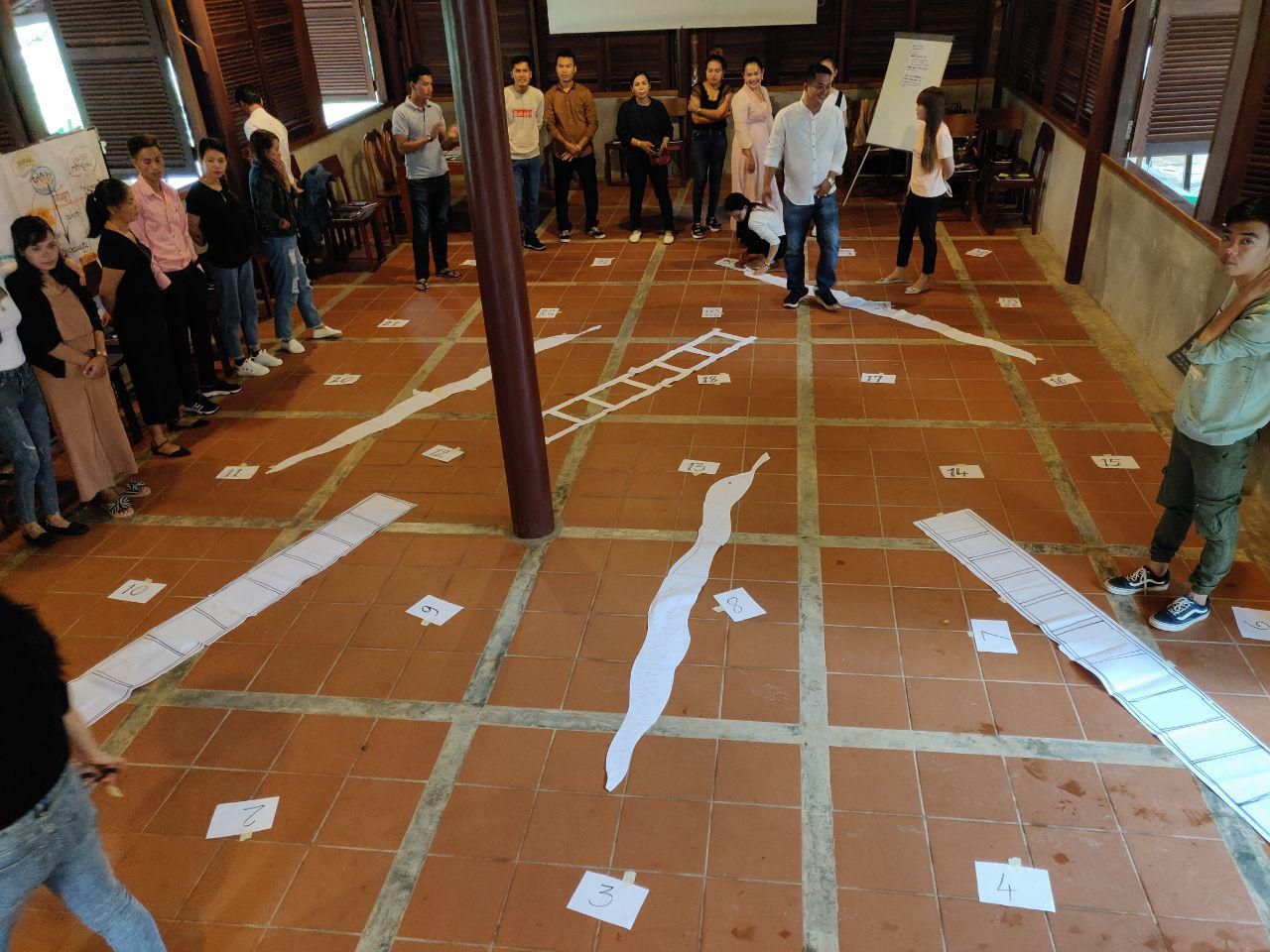
Our Snakes and Ladders game, where one of the workers was the first to reach the finish, showed that although incomes may differ, anyone can meet their monthly expenses. After the game we first had an exercise in small groups to reflect on expenses for the current month. Each group did charts on the various cost heads and the type of expenses. Since there were both workers and supervisors in these groups, there were of course disparities in monthly income. But because of the light-hearted atmosphere of the game there was an amazing openness to discuss this. People were comfortable sharing personal details.
In the second part we spoke about living wage and we asked them to calculate what living wage would mean. Then we discussed the concept of aspirational living, meaning that no matter how low or high your income is, everyone has this desire to establish a better livelihood, move to a better location, because that would mean a better school for your children, maybe a safer and cleaner environment et cetera.
Because of the open atmosphere it was possible to discuss the gap between the present – the minimum wage being less than the living wage – and the desired future. When someone of the WE team told us that in Switzerland, where she lives, the minimum wage in fact is higher than the living wage, everyone realised we still have a long way to go, but it is possible.”
In the second part we spoke about living wage and we asked them to calculate what living wage would mean. Then we discussed the concept of aspirational living, meaning that no matter how low or high your income is, everyone has this desire to establish a better livelihood, move to a better location, because that would mean a better school for your children, maybe a safer and cleaner environment et cetera.
Because of the open atmosphere it was possible to discuss the gap between the present – the minimum wage being less than the living wage – and the desired future. When someone of the WE team told us that in Switzerland, where she lives, the minimum wage in fact is higher than the living wage, everyone realised we still have a long way to go, but it is possible.”
POSTER
PARADE
TOLD BY ZAFAR
“We were doing a large human rights-workshop in a factory in Dhaka. The workshop included 35 people - workers and managers - out of a factory of 3500. They were excited about what they had learned and wanted to share it with their co-workers. After some discussion, they agreed on making visuals and we suggested to do posters. Then we discussed with them what the key message was and how they could add illustrations to create a powerful presentation.
We checked with the managers if they were okay with the workers coming onto the work floor and presenting their posters. As it turned out, they were very willing to help; they even brought out megaphones and tables to stand on. And then the workers came in, walking silently, holding the posters. The workers stopped their sewing machines and turned their heads to see. It was a very beautiful and powerful moment.
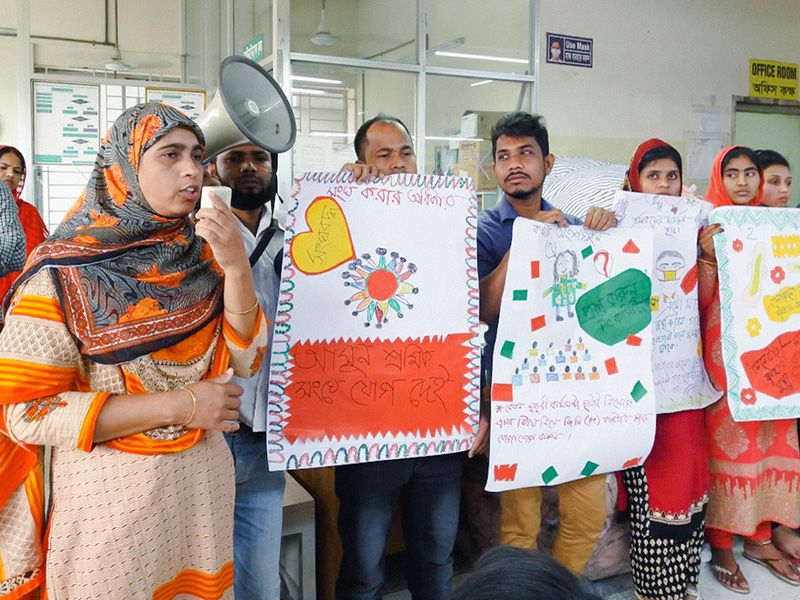
What happened that day was a surprise to all of us. For the factory workers, it was the first time that anything like this had come to the work floor. The approach and the message were new to them. The group who prepared the posters, was also amazed. They realised it was a very easy and accessible way of spreading a message. So to them, their parade was very empowering.
And to us, facilitators, the poster parade illustrated the possible ripple effect of our workshops. It brought the human rights messages from between the four walls of the WE Workshop to an open space. And to an audience. After we left, the parade was repeated on all seven floors of the factory. It took the WE team three weeks to reach 3500 people.”

